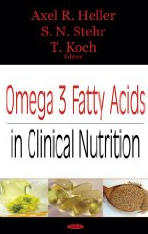Relevant ResourcesHealth Benefits of Omega 3 Fatty Acids Cod Liver Oil: The Number One Superfood Omega 3 Fish Oil and Alzheimer's Disease Important Precautions & Dangers
|
|---|
Foods Rich in Omega 3 Fatty Acids
Index of Diseases / Health Conditions
Please refer to Disclaimer and Precautions
Omega-3 fatty acids can be found in the following foods:
Vegetarian Sources:
| Common name | Linnaean name |
|---|---|
| Chia Seed or Chia Sage | Salvia hispanica |
| Kiwifruit or Chinese Gooseberry | Actinidia chinensis |
| Acai Palm Fruit | |
| Perilla or Shisho | Perilla frutescens |
| Flax Seeds or Linseed | Linum usitatissimum |
| Lingonberry or Cowberry | Vaccinium vitis-idaea |
| Camelina or Gold-of-Pleasure | Camelina sativa |
| Purslane or Portulaca | Portulaca oleracea |
| Black Raspberry | Rubus occidentalis |
| Butternuts | Juglans cinerea |
| Walnuts | Juglans regia |
| Pecan nuts | Carya illinoinensis |
| Hazel nuts | Corylus avellana |
| Hemp and linseed |
Dairy / Meats:
| Common name | Comments |
|---|---|
| Eggs | Eggs produced by chickens fed a diet of greens and insects produce higher levels of n−3 fatty acids (mostly ALA) than chickens fed corn or soybeans. In addition to feeding chickens insects and greens, fish oils may be added to their diet to increase the amount of fatty acid concentrations in eggs. |
| Wild-caught Cold-water Fish | A study published in the July 2008 issue of the Journal of the American Dietetic Association reports that the popular farm-raised fish known as tilapia and cat fish may actually harm your heart, due to the low levels of healthy omega-3 fatty acids and high levels of unhealthy omega-6 fatty acids. This combination could be particularly bad for patients with heart disease, arthritis, asthma and other diseases involving overactive inflammatory responses. There is evidence that you may harm yourself by eating farmed tilapia and catfish. |
| Meat |
Beef: The n−6 to n−3 ratio of grass-fed beef is about 2:1, making it a more useful source of n−3 than grain-fed beef, which usually has a ratio of 4:1. Lamb: Commercially available lamb is almost always grass-fed, and subsequently higher in n−3 than other common meat sources. Chicken: The omega-3 content of chicken meat may be enhanced by increasing the animals' dietary intake of grains such as flax, chia, and canola. |
Omega 3 Fatty Acids: Important Precautions & Dangers
Omega 3 Fatty Acids as Treatment for Depression
More Research & Information about Omega 3 Fatty Acids
Information contained on this website is provided as general advice only and does not replace the recommendation of a medical professional. Before beginning any treatment protocol, please consult with your doctor and/or vet.
In accordance with FDA regulation, we do not make any therapeutic claims for any Dietary Supplements in accordance with the Dietary Supplement Health and Education Act.
GreenAndHealthy.Info strives to maintain accurate and up-to-date information; however, mistakes do happen. If you would like to correct or update any of the information, please send us an e-mail. THANK YOU!



